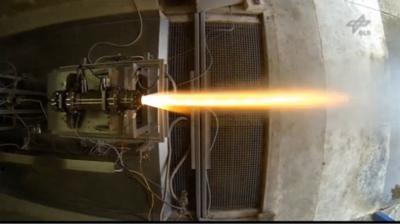Fri, Jan 31, 2014
DLR Engineers Research Tomorrow's Hybrid Engines
The concrete tube stretching across the German Aerospace Center (Deutsches Zentrum für Luft- und Raumfahrt; DLR) site in Trauen might be less than 11 feet wide, but every now and then it becomes outer space for around 10 seconds. This is the case when engineers at the DLR Institute of Aerodynamics and Flow Technology put their newly developed hybrid rocket engine through its paces.

Researchers take seats behind the 8-inch-thick, reinforced concrete walls in the control room while, in the test stand, liquid hydrogen peroxide reacts with solid fuel in a combustion chamber producing 530 pounds of thrust in the rocket engine. The first analyses of the Advanced Hybrid Rocket Engine Simulation (AHRES) project show that it might take just five to 10 years to develop an airworthy hybrid engine to launch a rocket into space.
By combining a solid propellant and liquid oxidizer in one engine, the DLR researchers hope to benefit from the advantages of both systems: "They are easier to build and handle than liquid propellant engines, which makes them less costly, and the fuels are not toxic," says DLR engineer Daniel Lancelle, listing the advantages. "You can control the thrust and ignite or switch off the engine as needed. The risk of explosion is also reduced in comparison with other engines." But the scientists are aware of the drawbacks of a hybrid engine – a lower combustion rate and reduced thrust. "At the moment we are working on understanding this new kind of engine and on improving the combustion rate and engine efficiency," explains researcher Ognjan BoA3/4iA. "And so far the results are promising."
A team comprised of DLR staff and students took it upon themselves to give the test stand at the DLR site in Trauen – unused for some 30 years – a makeover, installing state-of-the-art technology. Their purpose was to demonstrate that the hybrid rocket engine they had designed could work at least as efficiently as standard solid propellant engines. "You will not find another facility like this one in Europe," emphasizes Ognjan BoA3/4iA. The remote location of Trauen complies with all the safety standards required to plan future tests on larger engines with a thrust of up to 15 tons. Here, the engineers conduct tests with various solid fuels, modify the mixtures and analyze the course of combustion. The test results are then used to optimize the computer simulations.
This type of hybrid rocket engine could, for example, be used as the upper stage of a small to medium-sized launcher. "They can be deployed in research rockets and research aircraft operating at an altitude ranging from 40 to 180 kilometers – and therefore bridge the gap between airplanes and satellites," says project manager BoA3/4iA. They could also be used for spacecraft landings on the Moon and Mars. Their high degree of safety due to the separation of the different fuels before ignition opens up yet another field of application: space tourism.
"Our objective is to use the results obtained to develop engineering software that could be used by industry or research institutions to design this kind of engine or improve an existing design in just a few weeks," says DLR engineer Dennis Porrmann. Ognjan BoA3/4iA, Daniel Lancelle and Dennis Porrmann plan to conduct at least five more trials by mid-2015.
(Image provide by DLR)
More News
He Attempted To Restart The Engine Three Times. On The Third Restart Attempt, He Noticed That Flames Were Coming Out From The Right Wing Near The Fuel Cap Analysis: The pilot repor>[...]
Make Sure You NEVER Miss A New Story From Aero-News Network Do you ever feel like you never see posts from a certain person or page on Facebook or Instagram? Here’s how you c>[...]
From 2009 (YouTube Edition): Leading Air Show Performers Give Their Best Advice for Newcomers On December 6th through December 9th, the Paris Las Vegas Hotel hosted over 1,500 air >[...]
Aero Linx: NASA ASRS ASRS captures confidential reports, analyzes the resulting aviation safety data, and disseminates vital information to the aviation community. The ASRS is an i>[...]
“For our inaugural Pylon Racing Seminar in Roswell, we were thrilled to certify 60 pilots across our six closed-course pylon race classes. Not only did this year’s PRS >[...]
 NTSB Final Report: Rutan Long-EZ
NTSB Final Report: Rutan Long-EZ ANN FAQ: Turn On Post Notifications
ANN FAQ: Turn On Post Notifications Classic Aero-TV: ICAS Perspectives - Advice for New Air Show Performers
Classic Aero-TV: ICAS Perspectives - Advice for New Air Show Performers ANN's Daily Aero-Linx (06.28.25)
ANN's Daily Aero-Linx (06.28.25) Aero-News: Quote of the Day (06.28.25)
Aero-News: Quote of the Day (06.28.25)



